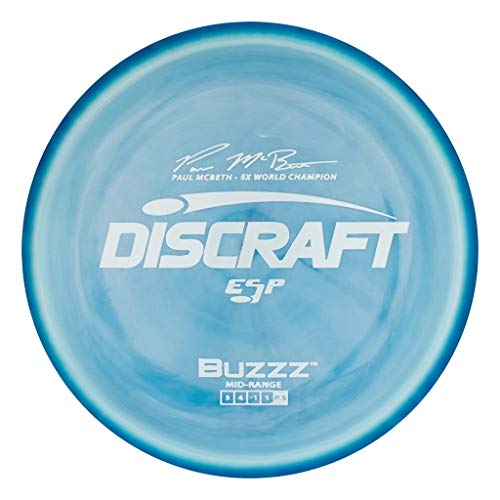The Discraft Buzzz is one of the all-time best midranges in disc golf. One comparable disc from the Latitude 64 brand is the Compass.
Both the Buzzz and the Compass are reliable midranges that are straight flyers and work exceptionally well as approach discs.
In this article, I’ll talk about both discs and explain the differences between the Discraft Buzzz and the Latitude 64 Compass!
Buzzz vs Compass Comparison
| Buzzz | Compass | |
| Flight | 5, 4, -1, 1 | 5, 5, 0, 1 |
| Stability | Stable | Stable |
| Skill Level | Everyone | Everyone |
| Rim | Beadless | Beadless |
| Plastics | Basic, Durable, Midgrade, Premium | Basic, Durable, Premium |
Discraft Buzzz
When I think of the Buzzz, consistency is the first word that comes to mind. I think many players would agree that it’s one of the best midranges ever created and that most disc golfers would improve their game with a disc like this.
One of the best features of the Buzzz is that it can be thrown for straight approaches like the Compass, but, it can also be thrown on a variety of angles.
This makes it more of a utility disc, especially when you can work in hyzer or anhyzer throws from the fairway.
Latitude 64 Compass
While it’s not the exact duplicate of the Buzzz, the Compass is what I consider the equivalent of the Latitude 64 brand. It’s just as easy to control and throw and happens to be a good choice for repeated throws.
Usually thrown from the fairway, aim anywhere you want and most likely the Compass will hit that exact line.
If you’re wondering about the grip and feel, the Compass is deeper than other mids like the Buzzz, although the beadless rim really helps to maintain angle control and clean releases.
Flight Numbers
Buzzz Flight Numbers: 5 Speed, 4 Glide, -1 Turn, 1 Fade
Compass Flight Numbers: 5 Speed, 5 Glide, 0 Turn, 1 Fade
Looking above you can see there aren’t any big differences in the flight numbers of the two discs. When thinking about how each disc will fly, the Buzzz can be thrown on more angles, while the Compass will fly straight for longer and have more glide overall.
Available Plastics
Buzzz Plastics: Titanium, ESP, Z, X, Pro-D
Compass Plastics: Opto Line, Gold Line, Opto Air, Opto Moonshine, Recycled, Retro
Since these discs are from two different brands, they have different plastics that the discs are available in. Although they have different names, it’s important to note that both the Buzzz and Compass are made using Basic, Durable, and Premium plastics.
Similarities Between the Buzzz and Compass
Here are some of the most important features that are similar between the Discraft Buzzz and Latitude 64 Compass.
Midrange Discs
The Discraft Buzzz and the Latitude 64 Compass are both midrange discs. These discs are used for similar throws, usually straight and low approaches to the basket.
With good angle control, they can easily be maneuvered around obstacles like trees or signs on the course.
They are Accurate and Controllable
One of the best parts about easy-to-throw discs is that there’s not as much pressure to have perfect aim and a clean release.
Especially with midranges as accurate as the Buzzz and Compass, they have forgiving flights that let you more easily control where your disc will land.
Both are Reliable Discs
One of the main reasons these discs are so popular is because so many disc golfers find themselves going back to use them when needing that reliable shot.
The reliability when throwing straight is something you can’t find in most other midrange or fairway discs.
Differences Between the two Midranges
There honestly aren’t too many important differences which is why they’re so often compared to one another.
Brand
The first and most obvious difference is that the Buzzz is a disc from Discraft while the Compass is from Latitude 64. Now what that means is that the flight numbers won’t match up exactly, and the options for weights and plastics will be different.
Even with different plastics and flight numbers, both discs can be found in similar plastic grades so it shouldn’t be too tough to match them up against each other.
Best Throws and Uses
Both discs are great for hitting tight gaps, tunnel shots, or even slow and straight approaches to the pin.
Hitting Gaps
Anytime there’s a narrow gap on the course, the Buzzz is the first disc that comes to my mind. There’s no better midrange at flying through the smallest area while still penetrating forward for extra distance.
With the Compass, you should be able to push the disc straight for longer because the natural fade starts to happen. So, if you’re trying to hit a small gap from a farther distance, I would probably go with the Compass over the Buzzz.
High Glide Approaches
Having glide numbers of 4 and 5 are pretty important for a midrange disc. Both of these discs can be thrown far without needing a lot of arm speed or power behind the throw.
That makes them the perfect option for when you need an accurate throw that will continue to stay in the air for more distance. The high glide also makes it easier to get a slow and clean landing near the basket, without the worry of your disc rolling away as it hits the ground.
Which Disc is Better For You?
If you want a disc that you can rely on to fly straight every time, the Buzzz is the better choice. If you are looking for a disc that will stay in the air and go straight for longer, the Compass is the disc to try out.
Conclusion
That’s everything there is to know about the Buzzz and the Compass, including the best uses, plastics, and key differences between these accurate midranges.
Although the Compass is so similar to the Buzzz, there are actually a handful of discs that fit the same category and best uses!


